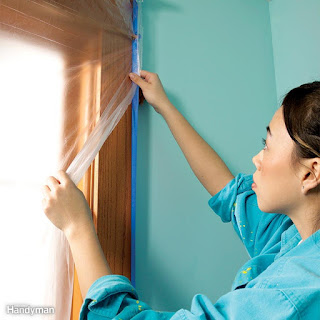10 House Painting Mistakes Almost Everyone Makes (and How to Avoid Them)
Choosing the Wrong Colors
One of the biggest, most devastating painting mistakes you can make happens before you even pick up a brush or roller. That mistake is basing your paint color choice on color chips. We've all done it. You pick out a nice color from the strip at the store and order your paint. But when you put the paint on the walls at home, it doesn’t look like the color you picked out. You can avoid this problem by asking the paint store to mix a small sample of paint that you can take home and try out on the wall, in both natural and artificial light, during the day and at night. Then if you don’t like it, you’re only out a few bucks.
Another paint-color related tip: If you're selling your home, don't choose bright colors. Buyers might not think your lime green kitchen is as cool as you do. Our advice: Keep it neutral
Making Rookie Mistakes
1. Leaving the lid off of the paint can. The most obvious problem with this bad habit is that someone is bound to step on the lid and track paint all over. But there are other reasons to put the lid back on immediately. It'll keep your paint clean and prevent dried-out paint crud from forming in the can or on the lid. Plus, you're less likely to get the lids from two similar colors mixed up, which can cause hassles later.
2. Forgetting to lock out pets. Here's what can and does happen—you step out of the room you're painting and pretty soon your dog is in there sniffing around. He grabs the paint brush handle in his mouth and carries it, dripping, across the house to give it back to you, leaving painted paw prints in his path. Avoid all pet-related painting problems by keeping your pets locked away from the project at all times
Bumping the Ceiling
One second of inattention is all it takes to bump the ceiling with the roller and create a troublesome touch-up job. You can avoid this problem by rolling on a horizontal strip of paint parallel to the ceiling first. Then roll vertically up to the horizontal strip. The 9-in.-wide strip of paint along the ceiling will give you a nice buffer zone.
Using the Wrong Paint
If you've chosen the wrong paint for the job, no matter how good your application technique is, the project isn't going to turn out well. Here are three situations to watch out for:
1. When painting surfaces that aren't perfect, don't choose paint with a high sheen. The glossiness will only accentuate the problems on the surface. Light reflecting off the shiny paint will highlight every defect. So if you want to paint with a semigloss or gloss sheen, make sure the surface you're painting is carefully prepared and perfectly smooth.
2. When covering a light-colored wall with dark paint, start with a tinted primer. Ask at the paint store for advice. The staff will know what tint to use. Gray primer is a great choice under most dark colors.
3. If you're painting with two sheens of the same color, be sure to label the cans. It's really easy to get the two mixed up, and you won't realize your mistake until the paint dries. You'll be really sorry if you accidentally touch up flat walls with semigloss paint.
Treating Untextured Ceilings Just Like Walls
A new drywall ceiling requires more care than a wall. Ask any painter and you're bound to hear a horror story about an untextured ceiling that showed every drywall seam no matter how many coats of paint were applied. This problem is more severe where window light shines across a large, unbroken ceiling.
Even the best drywall taping job isn't perfectly flat, and differences in texture between the taped spots and the drywall surface add to the problem. The best solution is to skim-coat the entire ceiling with a thin layer of joint compound. This helps feather out level differences, and more important, leaves a consistent surface for paint. Another fix is to roll on a special high-solids paint made for this purpose.
Painting Wood Without a Stain Blocker
Red cedar, redwood and cypress all have tannins that bleed through most latex paint. Fix the problem by priming these types of wood with a stain-blocking primer. Look for "tannin blocking" on the label.
Painting in Low Light
Avoid painting interior surfaces in dim light. The painted surface may look fine at first, but when you uncover the windows to let in natural light, or turn on bright lights, you'll likely see thin patches and other imperfections. Always make sure to have lots of bright light when painting.
Painting Over Glossy Finishes
When you paint over any surface that already has a coat of varnish or glossy paint, make sure to give the surface some "tooth" first so the new paint will stick. Thorough sanding will work, but wiping the surface with a liquid deglosser is easier and more effective. You'll find deglosser wherever paint is sold.
Letting the Roller Touch the Floor
If you're painting new walls before the baseboard is installed, leave an unpainted strip along the bottom where it will be covered by the baseboard. If you try to paint too close to the floor, your roller cover could touch it and pick up dirt, lint and hair that you will then spread across the wall.
Spray Painting Without Covering Everything
Don't underestimate overspray from spray cans or paint sprayers. Cover everything in sight with thin plastic or drop cloths. And if you're working outdoors, don't spray on a windy day. The mist can drift a long way, and you may end up having to pay for a detailing job on your neighbor's car.
Larkins Affordale Painting (727) 342-9891











Comments
Post a Comment